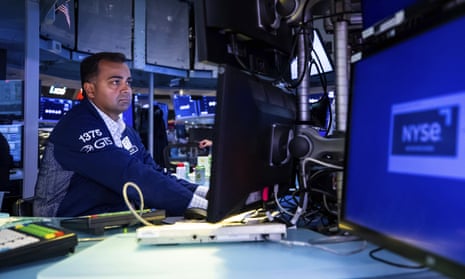US stock markets suffered their worst day of the year on Thursday as investors worried about the Federal Reserve’s plans to raise interest rates to tackle soaring inflation.
The Dow Jones Industrial Average lost over 1,000 points (3.1%). The S&P 500 and Nasdaq Composite fell 3.5% and 4.9% respectively. Tech stocks were particularly hard-hit, with Amazon dropping 7.6% and Tesla falling 8.3%.
The steep fall came one day after the Fed chair, Jerome Powell, announced the sharpest rise in interest rates in over 20 years. With inflation now running at an annual rate of 8.5%, a 40-year high in the US, Powell said the Fed needed to do “everything we can to restore stable prices”.
The half-percentage-point increase in rates had been widely signaled, and Powell’s comments that the Fed was not considering raising interest rates by 0.75 percentage points at a future meeting were initially welcomed by Wall Street, with stock markets recording their biggest one-day gain since 2020. But those gains evaporated on Thursday as traders worried about the impact of the Fed’s moves on demand, and on the wider economy.
“The Fed is between a rock and a hard place, and because of instant information, investors are experiencing both fear and greed at the exact same moment,” said Sam Stovall, chief investment strategist at CFRA. “Investors realized that by the Fed continuing to take a very measured approach, it could actually allow inflation to remain out of control.”
The Fed’s aggressive shift to raise interest rates has investors worrying about whether it can pull off the delicate dance to slow the economy enough to halt high inflation but not so much as to cause a downturn. The pace and size of interest rate increases is being scrutinized closely on Wall Street.
Diminishing the odds of a 0.75-point hike doesn’t mean the Fed is done raising rates steadily and sharply as it fights to tame inflation. Economists at BNP Paribas still expect the Fed to keep hiking the federal funds rate until it reaches a range of 3% to 3.25%, up from zero to 0.25% earlier this year.
“We do not think this was Chair Powell’s intention,” economists at BNP Paribas wrote in a report, citing the market’s jubilance on Wednesday, “and we reckon we could see coming ‘Fedspeak’ seek to re-tighten financial conditions.”
The selloff came as the Bank of England on Thursday raised its benchmark interest rate to the highest level in 13 years and forecast inflation would rise above 10% this year, the highest level since 1982.
Energy markets remain volatile as the conflict in Ukraine continues and demand remains high amid tight supplies of oil. European governments are trying to replace energy supplies from Russia and are considering an embargo. Opec and allied oil-producing countries decided Thursday to gradually increase the flows of crude they send to the world.
Higher oil and gas prices have been contributing to the uncertainties weighing on investors as they try to assess how inflation will ultimately impact businesses, consumer activity and overall economic growth.
Rising rates are already affecting the US house market, where home prices soared through the pandemic. The average rate on a 30-year fixed-rate mortgage rose to 5.27% this week, its highest level since 2009, according to the mortgage buyer Freddie Mac. A year ago, it averaged 2.96%. Mortgage rates tend to follow moves in the 10-year treasury yield. The sharp increase in mortgage rates has strained affordability for homebuyers after years of sharply rising prices.
The Associated Press contributed to this story
